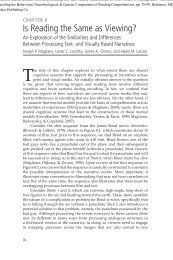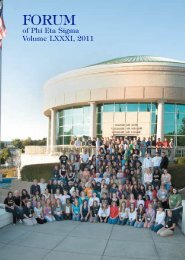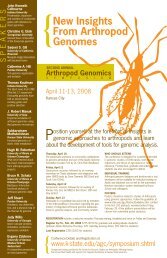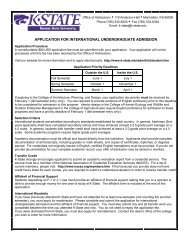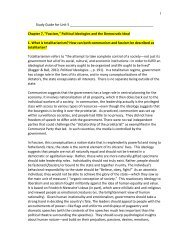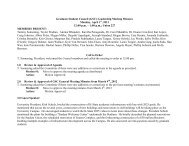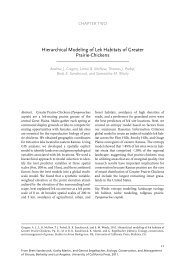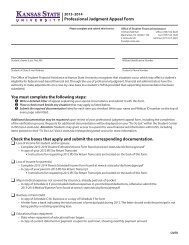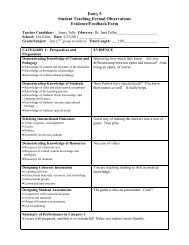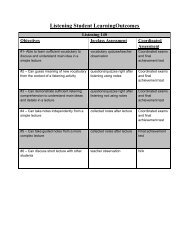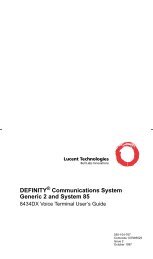405 Church Street Suite 2 www.sightlines.com Guilford, CT 06437 ...
405 Church Street Suite 2 www.sightlines.com Guilford, CT 06437 ...
405 Church Street Suite 2 www.sightlines.com Guilford, CT 06437 ...
Create successful ePaper yourself
Turn your PDF publications into a flip-book with our unique Google optimized e-Paper software.
<strong>405</strong> <strong>Church</strong> <strong>Street</strong><br />
<strong>Suite</strong> 2<br />
<strong>Guilford</strong>, <strong>CT</strong> <strong>06437</strong><br />
Phone: (203) 682-4950<br />
<strong>www</strong>.<strong>sightlines</strong>.<strong>com</strong>
Overview<br />
Sightlines, LLC has been working with Kansas State University since May of 2010 and has since <strong>com</strong>piled seven years of annual data for state<br />
supported space on the Manhattan and Veterinary Medicine campus. Sightlines quantified the data presented within this report by a site visit to<br />
Kansas State University. Once collected, the data was both verified as accurate and qualified to ensure <strong>com</strong>parability and accuracy. Additionally,<br />
the information has been analyzed in terms of progress toward goals and objectives defined jointly between Kansas State University and Sightlines,<br />
and fairly present the operations and capital portfolio for the university. (For a list of peer institutions used within this report, please see Appendix I).<br />
Section I: Institutional Findings<br />
Core Issues:<br />
There are three major issues impacting the physical assets of Kansas State University in FY2011:<br />
• Age of space: With no record of major renovations being done on campus, 90% of space is now over twenty five years old making K-State the<br />
oldest campus among its peers. Reaching twenty five years old is a critical age in a building’s lifecycle as it is the threshold when many major<br />
building <strong>com</strong>ponents begin requiring capital investment.<br />
• Capital investment: While total capital investment has increased significantly over time in order to cope with increased need, there has been a<br />
lack of historical capital investment. Spending has been concentrated on envelope/mechanical types of projects leaving limited funding for<br />
space/programming types of projects.<br />
• Operations Profile: While total daily operating costs are near the peer average, K-State is spending more on utilities, leaving less funding for<br />
daily service and planned maintenance work. Despite limited funding, Division of Facilities is providing results <strong>com</strong>parable to peer institutions as<br />
evidenced in the campus inspection results.
Key Re<strong>com</strong>mendations:<br />
• Considering the “K-State 2025” vision, it is important to address the age of space on campus to remain <strong>com</strong>petitive and gain standing in the top<br />
50 research institutions.<br />
• While capital funding has grown to meet the peer average in FY11, K-State has seen limited capital investment historically. This, paired with an<br />
older and aging campus, has lead to a growing backlog of reinvestment need which is likely much higher than the current in-house study<br />
reflects. Updating the backlog study will provide the university with a tool to guide capital investment toward the areas of highest need.<br />
• With available capital, K-State has done a good job with concentrating on envelope/mechanical types of projects which have a larger impact on<br />
extending the life of spaces on campus. However, in doing so, K-State has fallen behind in modernizing programmatic spaces. Be mindful of the<br />
implications a lack of space/program investment can bring. Underfunding has likely led to a misalignment of available spaces and program<br />
demands.<br />
• Older, less efficient spaces on campus have lead to K-State consuming more energy than peers. Due to the high energy consumption, 51% of<br />
K-State’s operating budget is spent on utilities, leaving fewer funds available for day-to-day campus operations. Addressing the age of space<br />
and increasing the efficiency of spaces on campus can free up operational resources to be redistributed toward planned maintenance funding.<br />
• Division of Facilities is often doing more with fewer resources than peers. While achieving favorable results, effectiveness is impacted by the<br />
age of campus, limited daily service budget dollars and planned maintenance due to high utility expenses. Work to reduce energy consumption<br />
and reallocate any released budget dollars toward planned maintenance.<br />
Section II: Supporting Analysis<br />
Sightlines, LLC conducts its analysis of institutions’ physical assets in the framework of 4<br />
major axes: Annual Stewardship, Asset Reinvestment, Operating Effectiveness, and<br />
Service. Although each axis will highlight specific areas of physical asset management for<br />
which Division of Facilities is responsible, the <strong>com</strong>ponents are heavily interrelated and thus<br />
any major change in one area has a corresponding effect on another. The core issues<br />
presented below incorporate areas of focus from each of these axes (please see appendices<br />
for detailed explanations of the four axes).<br />
Understanding campus age: Age is the driving factor of many capital and operational<br />
stressors at Kansas State University. Since 2005, there have been no major changes to the<br />
space profile at K-State and as a result space has continued to age on a linear trajectory. In<br />
FY2011, 90% of space at K-State is over 25 years old. Not only is a majority of space older<br />
than 25 years, but the average age of each square foot of space on campus is over 56<br />
years, making K-State the oldest school among its peers (who are 39 years old on average)<br />
and the second oldest school among the top 50 research institutions within Sightlines’<br />
database. See figure 1.<br />
Impact of age on capital demands: The 25-year old mark in the life of a building signifies<br />
a threshold when major building <strong>com</strong>ponents begin to reach the end of their useful life.<br />
Extending the useful life of these <strong>com</strong>ponents and keeping up with system failures requires<br />
significant investment of capital resources. Over the last seven years, Kansas State has
amped up capital spending to address these needs on campus. Spending<br />
has risen from $0.51/GSF in FY2005 to $4.50/GSF in FY2011, an 800%<br />
increase. While the increase is significant, it is important to note that the<br />
additional capital resources have not set Kansas State apart from peers. They<br />
have merely brought the university up to peer average levels in FY2011. A<br />
history of limited capital investment has led to the accumulation of a backlog<br />
of deferred maintenance need. Deferred maintenance need paired with<br />
modernization need due to the age of space and infrastructure need creates a<br />
holistic look at the total capital reinvestment demands on campus. At K-State,<br />
Sightlines estimates the total backlog is likely $110/GSF, this is based on age<br />
using parameters set by backlog studies that Sightlines has conducted on<br />
other college and university campuses nationwide. See figure 2.<br />
Impact of age on institutional programs: The increase in capital spending<br />
has been largely due to failing systems and state stimulus funding earmarked<br />
for the envelope and mechanical needs of campus spaces. 76% of capital<br />
investment in the last seven years has been spent on envelope and<br />
mechanical types of projects leaving just 24% of funding for space and<br />
programming need. Considering the age and capital profiles of Kansas State<br />
University, it is likely that spaces available are out of alignment with<br />
institutional program needs. With space that is nearing 60 years old<br />
and limited funding to update that space, the classroom size and<br />
technology within those classrooms are outdated. At Kansas State<br />
the average capacity of a general use classroom is 58.4 seats and<br />
85% of classrooms hold 30 or more seats. According to the <strong>com</strong>mon<br />
data set, 72% of classes scheduled have fewer than 30 students<br />
enrolled while only 15% of classrooms have a corresponding<br />
capacity. While it is immediately apparent that appropriately sized<br />
classrooms can be utilized more efficiently, the impact of limited<br />
technology is less apparent. Based on space utilization studies<br />
performed at other colleges and universities in Sightlines’ database,<br />
findings show that classrooms with higher levels of technology are<br />
typically more highly utilized. At Kansas State, only 6% of general<br />
use classrooms are considered to have a high technology score. A<br />
<strong>com</strong>bination of wrongly sized classrooms and limited technology<br />
within those classrooms may be negatively impacting institutional<br />
programs and the utilization of space at Kansas State University.<br />
See figure 3.
Impact of age on operational demands: There is a unique mix of<br />
form and function at Kansas State University. Even though campus is<br />
so old, nearly 50% of the total GSF is dedicated Science Research<br />
space in accordance with the “K-State 2025” vision to be a top 50<br />
research institution in the United States. High intensity programs<br />
inside of old, inefficient building shells are contributing to energy<br />
consumption at K-State that is nearly 40% higher than the peer<br />
average in FY11. Such high energy consumption is requiring K-State<br />
to allocate 51% of the facilities operating budget to utilities while<br />
peers are allocating only 33% to utilities. This leaves K-State with<br />
$0.76/GSF less for daily operating resources <strong>com</strong>pared to peers,<br />
which is a large difference considering the total operating resources<br />
for K-State are $2.96/GSF (excluding utilities). See figures 4.<br />
Closing Comments<br />
As the economic atmosphere in higher education remains cautious, strategic and targeted project selection has be<strong>com</strong>e even more important. At<br />
Kansas State the importance of project selection is heightened by an old, continually aging campus profile and a lack of historic project spending.<br />
An updated, <strong>com</strong>prehensive backlog analysis will allow the university to record and prioritize all campus needs, integrating long-range capital plans<br />
with current investments. A backlog study can highlight economic opportunities on campus like energy conservation projects that will reduce<br />
consumption and payback the initial project cost. Operational funding for utility consumption freed up through capital investment can be redirected<br />
to areas of critical daily service needs such as planned maintenance.<br />
Managing the allocation of resources will be particularly important at Kansas State as the University strives to meet the “K-State 2025” vision. As<br />
programs change and evolve, it is necessary that programmatic spaces change and evolve in conjunction. It is essential that Kansas State have a<br />
strong understanding of available physical resources in order to best align them with programmatic needs. A space utilization study can provide the<br />
information necessary to adapt current spaces on campus to new demands and increase the efficiency of space being used. This study can be<br />
paired with a backlog analysis to highlight needs that will have the largest, most immediate spatial and programmatic impact and ensure that<br />
institutional resources are used to reach the best out<strong>com</strong>e.
Appendix I – Peer Comparisons<br />
The following institutions have been determined as a representative peer <strong>com</strong>parison group based upon size, <strong>com</strong>plexity, age, status as a landgrant<br />
institution, status as a Top 50 Research institution and membership of the Big 12 Conference.<br />
• Clemson University+~<br />
• Iowa State University*+~<br />
• Michigan State University+~<br />
• Oregon State University+<br />
• Purdue University+~<br />
• Texas A&M University*+~<br />
• The Ohio State University+~<br />
• The Pennsylvania State University+~<br />
• The University of Mississippi+<br />
• The University of Oklahoma*<br />
• University of Arkansas+<br />
• University of Colorado – Boulder~<br />
• University of Illinois - Urbana/Champaign+~<br />
• University of Missouri – Columbia*~<br />
• West Virginia University+<br />
*Member of the Big 12 conference<br />
+Land-grant institution (as designated by state legislature)<br />
~Top 50 Research Institution (as designated by The Center for Measuring University Performance)
Appendix II – Annual Stewardship<br />
The annual facilities stewardship metric demonstrates a campus’s ability to preserve its physical assets. The gap between the annual need and<br />
actual funding determines an institution’s deterioration rate. This is a long-term indicator of financial and operational performance, however most<br />
institutions lack the measurement tools to quantify it. The ROPA SM model utilizes the following metrics to quantify the draw on physical assets.<br />
Envelope & Mechanical Systems Maintenance<br />
Envelope & Mechanical Maintenance, defined as the “hard” maintenance needs of a building, assures the replacement of key building <strong>com</strong>ponents<br />
as they reach the end of their useful life. These <strong>com</strong>ponents include such basic items as the roof, windows, doors, pointing, boilers, chillers, piping,<br />
and electrical service. The total cycle maintenance need is calculated based on the technical <strong>com</strong>plexity of each building. The actual investment is<br />
readily assembled by the review of operating and capital budget expenditures for each year. The difference between the annual need and the actual<br />
annual investment defines the envelope/mechanical deferral for a given year. This list of deferred needs adds to the asset reinvestment backlog.<br />
Space and Program Renewal<br />
The space and program need, in contrast to cycle maintenance needs, are the “soft” renewal requirements of a building that assure the interior<br />
space supports the program housed within a given facility. These <strong>com</strong>ponents include such items as finishes, furnishings, fixed equipment, space<br />
layout, and the support systems to provide electricity, air movement, heating and cooling. The total space and program need is based on the<br />
technical <strong>com</strong>plexity, age, and function of each building. The actual investment is extracted from the operating and capital expenditures for each<br />
year. The difference between the annual need and the actual spending defines the amount of space/program needs deferred and subsequently<br />
added to the asset reinvestment backlog each year.
Appendix III – Asset Reinvestment<br />
The asset reinvestment dimension quantifies a campus’s backlog of maintenance/repair, modernization and infrastructure needs and its<br />
demonstrated capacity to address them. The first <strong>com</strong>ponent is the value of the entire inventory of these deferred needs, or backlog. From the<br />
priorities assigned to each item in this inventory <strong>com</strong>es the value of the top priority items, and the associated time frame within which they are to be<br />
performed.<br />
The Asset Reinvestment quadrant of the model only addresses the need of, and the investments in, existing facilities. The cost to construct new<br />
facilities is not factored into the asset reinvestment analysis. The campus’s one-time capital investments in existing facilities (excluding investments<br />
from operating and recurring capital funds) over the previous three years are reviewed, averaged (to establish an annual asset reinvestment rate),<br />
and projected over the same number of years estimated for the top priority projects. This projection <strong>com</strong>pared to the value of this priority backlog of<br />
needs in that same time frame determines if the current asset reinvestment rate will meet, exceed, or fall short of funding the campus’s top priority<br />
deferred maintenance and modernization needs. (Operating funds investments in preventive and planned maintenance and recurring capital funds<br />
investments in capital renewal projects are excluded from asset reinvestment consideration because while they add value to, extend, or maintain<br />
the useful lives of existing <strong>com</strong>ponents, they do not eliminate deferred maintenance backlogs).<br />
<strong>405</strong> <strong>Church</strong> <strong>Street</strong><br />
<strong>Suite</strong> 2<br />
<strong>Guilford</strong>, <strong>CT</strong> <strong>06437</strong><br />
Phone: (203) 682-4950<br />
<strong>www</strong>.<strong>sightlines</strong>.<strong>com</strong>
Appendix IV – Operating Effectiveness<br />
Traditional facilities benchmarking efforts have generally focused on operating cost and consumption statistics. While these benchmarks are<br />
valuable in providing a context from which to assess performance, their utility is limited because they are not reconciled to institutional mission and<br />
organizational goals. The ROPA SM model incorporates mission and goals, with its benchmarks as a way of understanding the trade-offs between<br />
service, operating processes, asset reinvestment, and annual stewardship.<br />
Operating Budget Analysis<br />
Facilities budgets are <strong>com</strong>posed of daily services, preventive maintenance, and utilities. Illustrating the distribution of these costs is helpful in<br />
guiding the operational focus within the facilities organization. The ROPA SM model evaluates these budgets by creating a matrix of expenditure<br />
blocks (salaries and wages, benefits, expenses, utilities, equipment and in<strong>com</strong>e) to ascertain the “gross” maintenance expenditures, and<br />
expenditure programs – daily service, planned maintenance (Planned projects and preventive maintenance on equipment), and utilities. (Nonfacilities<br />
items such as security, mail service, and motor pools are excluded.)<br />
Energy Cost and Consumption<br />
Large portions of facilities budgets are dedicated to utilities. Evaluating the dollars spent per unit of energy, as well as actual energy consumed, is<br />
invaluable in making decisions regarding the procurement of fuel, new equipment, and even new facilities.<br />
Operations Performance<br />
This series of measures is a guide to the management of facilities departments when properly reconciled with institutional mission. The ROPA SM<br />
model uses metrics of staffing per gross square foot, materials per FTE, workers per supervisor, and work order production to illustrate operating<br />
effectiveness. These factors be<strong>com</strong>e invaluable performance measurements over time.<br />
<strong>405</strong> <strong>Church</strong> <strong>Street</strong><br />
<strong>Suite</strong> 2<br />
<strong>Guilford</strong>, <strong>CT</strong> <strong>06437</strong><br />
Phone: (203) 682-4950<br />
<strong>www</strong>.<strong>sightlines</strong>.<strong>com</strong>
Appendix V – Service<br />
The service evaluation scale measures the quality of service delivery as perceived by the customer. This scale is a <strong>com</strong>posite of three indices:<br />
Service Process Review, Space Inspection, and Customer Satisfaction. From the assembled information, discussions and a review of a sample of<br />
facilities, assigned scores are summarized in the following manner.<br />
1. Service Process:<br />
a. Centralization of Customer Service Requests<br />
b. Scheduling Process Division – What & When vs. Who & How<br />
c. Organizational Structure and Position<br />
d. Work Order System – Overall capabilities<br />
e. Performance Measurement – Backlog, Schedule, Dates, Repeats, …<br />
2. Campus Inspection:<br />
a. Cleanliness<br />
b. General Repair<br />
c. Mechanical Systems<br />
d. Facility Exterior<br />
e. Grounds<br />
3. Customer Satisfaction:<br />
a. Knowledge/Understanding of Process<br />
b. Schedules and Service Levels<br />
c. Work Meets Expectations<br />
d. Feedback Opportunity<br />
e. General Satisfaction with Service
Appendix VI – Sightlines Member Website<br />
Sightlines 4.0 is the new and improved version of the Sightlines member website. Its great new features and enhancements make it easier to turn<br />
Data into Information and harness the Knowledge to take Action. A more powerful and user-friendly interface along with a simpler and more<br />
intuitive benchmarking engine provides Sightlines members with even faster access to <strong>com</strong>parative data. Choose your metrics and manage your<br />
<strong>com</strong>parative groups with ease.<br />
Here are just a few of the new enhancements:<br />
• Improved Design and Navigation — Our new<br />
layout is easier to read, navigate, and adjust to<br />
ac<strong>com</strong>modate any screen size.<br />
• New Benchmarking Process — An entirely new<br />
benchmarking process makes it easier to generate<br />
<strong>com</strong>parisons. You’ll be able to manage<br />
<strong>com</strong>parative groups and download data with<br />
greater control and fewer clicks. The new user<br />
interface provides easy access to benchmarks,<br />
longitudinal performance metrics, and deliverables,<br />
all in one central location.<br />
• Member Forum — Don’t feel like you’re alone in the<br />
process of facility improvement. Chat with<br />
colleagues and ask questions in our new Member<br />
Forum — a great way to improve your knowledge<br />
of specific issues and problems occurring<br />
nationwide.<br />
As always, Sightlines members will continue to enjoy<br />
access to the largest verified database of facilities<br />
metrics in the country. Our QVQ Process (Quantify,<br />
Verify, and Qualify) ensures consistent analysis and<br />
<strong>com</strong>parable benchmarking.



